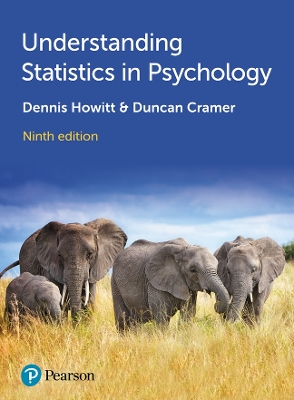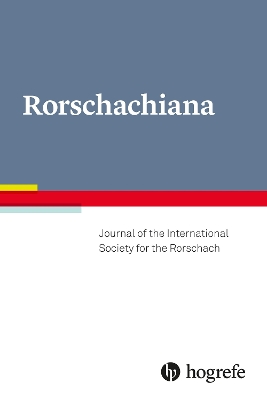Understanding Statistics in Psychology
 portes grátis
portes grátis
Understanding Statistics in Psychology
Cramer, Duncan; Howitt, Dennis
Pearson Education Limited
11/2024
680
Mole
9781292465180
Pré-lançamento - envio 15 a 20 dias após a sua edição
Descrição não disponível.
Preface
Why statistics?
Part 1 Descriptive statistics
Some basics: Variability and measurement
Describing variables: Tables and diagrams
Describing variables numerically: Averages, variation and spread
Shapes of distributions of scores
Standard deviation and z-scores: Standard unit of measurement in statistics
Relationships between two or more variables: Diagrams and tables
Correlation coefficients: Pearson's correlation and Spearman's rho
Regression: Prediction with precision
Part 2 Significance testing
Samples from populations
Statistical significance for the correlation coefficient: Practical introduction to statistical inference
Standard error: Standard deviation of the means of samples
Related or paired-samples t-test: Comparing two samples of related/correlated/paired scores
Unrelated or independent-samples t-test: Comparing two samples of unrelated/uncorrelated/independent scores
What you need to write about your statistical analysis
Confidence intervals
Effect size in statistical analysis: Do my findings matter?
Chi-square: Differences between samples of frequency data
Probability
One- versus two-tailed or -sided significance testing
Ranking tests: Nonparametric statistics
Part 3 Introduction to analysis of variance
Variance ratio test: F-ratio to compare two variances
Analysis of variance (ANOVA): One-way unrelated or uncorrelated ANOVA
ANOVA for correlated scores or repeated measures
Two-way or factorial ANOVA for unrelated/uncorrelated scores: Two studies for the price of one?
Multiple comparisons in ANOVA: A priori and post hoc tests
Mixed-design ANOVA: Related and unrelated variables together
Analysis of covariance (ANCOVA): Controlling for additional variables
Multivariate analysis of variance (MANOVA)
Discriminant (function) analysis - especially in MANOVA
Statistics and analysis of experiments
Part 4 More advanced correlational statistics
Partial correlation: Spurious correlation, third or confounding variables, suppressor variables
Factor analysis: Simplifying complex data
Multiple regression and multiple correlation
Path analysis
Analysis of a questionnaire/survey project
Part 5 Assorted advanced techniques
Meta-analysis: Combining and exploring statistical findings from previous research
Reliability in scales and measurement: Consistency and agreement
Influence of moderator variables on relationships between two variables
Statistical power analysis: Getting the sample size right
Part 6 Advanced qualitative or nominal techniques
Log-linear methods: Analysis of complex contingency tables
Multinomial logistic regression: Distinguishing between several different categories or groups
Binomial logistic regression
Part 7 Bringing things together
Data mining and Big Data
Towards a masterplan
Appendices
Glossary
References
Index
Why statistics?
Part 1 Descriptive statistics
Some basics: Variability and measurement
Describing variables: Tables and diagrams
Describing variables numerically: Averages, variation and spread
Shapes of distributions of scores
Standard deviation and z-scores: Standard unit of measurement in statistics
Relationships between two or more variables: Diagrams and tables
Correlation coefficients: Pearson's correlation and Spearman's rho
Regression: Prediction with precision
Part 2 Significance testing
Samples from populations
Statistical significance for the correlation coefficient: Practical introduction to statistical inference
Standard error: Standard deviation of the means of samples
Related or paired-samples t-test: Comparing two samples of related/correlated/paired scores
Unrelated or independent-samples t-test: Comparing two samples of unrelated/uncorrelated/independent scores
What you need to write about your statistical analysis
Confidence intervals
Effect size in statistical analysis: Do my findings matter?
Chi-square: Differences between samples of frequency data
Probability
One- versus two-tailed or -sided significance testing
Ranking tests: Nonparametric statistics
Part 3 Introduction to analysis of variance
Variance ratio test: F-ratio to compare two variances
Analysis of variance (ANOVA): One-way unrelated or uncorrelated ANOVA
ANOVA for correlated scores or repeated measures
Two-way or factorial ANOVA for unrelated/uncorrelated scores: Two studies for the price of one?
Multiple comparisons in ANOVA: A priori and post hoc tests
Mixed-design ANOVA: Related and unrelated variables together
Analysis of covariance (ANCOVA): Controlling for additional variables
Multivariate analysis of variance (MANOVA)
Discriminant (function) analysis - especially in MANOVA
Statistics and analysis of experiments
Part 4 More advanced correlational statistics
Partial correlation: Spurious correlation, third or confounding variables, suppressor variables
Factor analysis: Simplifying complex data
Multiple regression and multiple correlation
Path analysis
Analysis of a questionnaire/survey project
Part 5 Assorted advanced techniques
Meta-analysis: Combining and exploring statistical findings from previous research
Reliability in scales and measurement: Consistency and agreement
Influence of moderator variables on relationships between two variables
Statistical power analysis: Getting the sample size right
Part 6 Advanced qualitative or nominal techniques
Log-linear methods: Analysis of complex contingency tables
Multinomial logistic regression: Distinguishing between several different categories or groups
Binomial logistic regression
Part 7 Bringing things together
Data mining and Big Data
Towards a masterplan
Appendices
Glossary
References
Index
Este título pertence ao(s) assunto(s) indicados(s). Para ver outros títulos clique no assunto desejado.
Quantitative accessible basics beginner research descriptive statistics significance testing ANOVA MANOVA T-test variance correlation hypothesis data analysis mining report experiment sample test measurement reliability validity write-up regression project design
Preface
Why statistics?
Part 1 Descriptive statistics
Some basics: Variability and measurement
Describing variables: Tables and diagrams
Describing variables numerically: Averages, variation and spread
Shapes of distributions of scores
Standard deviation and z-scores: Standard unit of measurement in statistics
Relationships between two or more variables: Diagrams and tables
Correlation coefficients: Pearson's correlation and Spearman's rho
Regression: Prediction with precision
Part 2 Significance testing
Samples from populations
Statistical significance for the correlation coefficient: Practical introduction to statistical inference
Standard error: Standard deviation of the means of samples
Related or paired-samples t-test: Comparing two samples of related/correlated/paired scores
Unrelated or independent-samples t-test: Comparing two samples of unrelated/uncorrelated/independent scores
What you need to write about your statistical analysis
Confidence intervals
Effect size in statistical analysis: Do my findings matter?
Chi-square: Differences between samples of frequency data
Probability
One- versus two-tailed or -sided significance testing
Ranking tests: Nonparametric statistics
Part 3 Introduction to analysis of variance
Variance ratio test: F-ratio to compare two variances
Analysis of variance (ANOVA): One-way unrelated or uncorrelated ANOVA
ANOVA for correlated scores or repeated measures
Two-way or factorial ANOVA for unrelated/uncorrelated scores: Two studies for the price of one?
Multiple comparisons in ANOVA: A priori and post hoc tests
Mixed-design ANOVA: Related and unrelated variables together
Analysis of covariance (ANCOVA): Controlling for additional variables
Multivariate analysis of variance (MANOVA)
Discriminant (function) analysis - especially in MANOVA
Statistics and analysis of experiments
Part 4 More advanced correlational statistics
Partial correlation: Spurious correlation, third or confounding variables, suppressor variables
Factor analysis: Simplifying complex data
Multiple regression and multiple correlation
Path analysis
Analysis of a questionnaire/survey project
Part 5 Assorted advanced techniques
Meta-analysis: Combining and exploring statistical findings from previous research
Reliability in scales and measurement: Consistency and agreement
Influence of moderator variables on relationships between two variables
Statistical power analysis: Getting the sample size right
Part 6 Advanced qualitative or nominal techniques
Log-linear methods: Analysis of complex contingency tables
Multinomial logistic regression: Distinguishing between several different categories or groups
Binomial logistic regression
Part 7 Bringing things together
Data mining and Big Data
Towards a masterplan
Appendices
Glossary
References
Index
Why statistics?
Part 1 Descriptive statistics
Some basics: Variability and measurement
Describing variables: Tables and diagrams
Describing variables numerically: Averages, variation and spread
Shapes of distributions of scores
Standard deviation and z-scores: Standard unit of measurement in statistics
Relationships between two or more variables: Diagrams and tables
Correlation coefficients: Pearson's correlation and Spearman's rho
Regression: Prediction with precision
Part 2 Significance testing
Samples from populations
Statistical significance for the correlation coefficient: Practical introduction to statistical inference
Standard error: Standard deviation of the means of samples
Related or paired-samples t-test: Comparing two samples of related/correlated/paired scores
Unrelated or independent-samples t-test: Comparing two samples of unrelated/uncorrelated/independent scores
What you need to write about your statistical analysis
Confidence intervals
Effect size in statistical analysis: Do my findings matter?
Chi-square: Differences between samples of frequency data
Probability
One- versus two-tailed or -sided significance testing
Ranking tests: Nonparametric statistics
Part 3 Introduction to analysis of variance
Variance ratio test: F-ratio to compare two variances
Analysis of variance (ANOVA): One-way unrelated or uncorrelated ANOVA
ANOVA for correlated scores or repeated measures
Two-way or factorial ANOVA for unrelated/uncorrelated scores: Two studies for the price of one?
Multiple comparisons in ANOVA: A priori and post hoc tests
Mixed-design ANOVA: Related and unrelated variables together
Analysis of covariance (ANCOVA): Controlling for additional variables
Multivariate analysis of variance (MANOVA)
Discriminant (function) analysis - especially in MANOVA
Statistics and analysis of experiments
Part 4 More advanced correlational statistics
Partial correlation: Spurious correlation, third or confounding variables, suppressor variables
Factor analysis: Simplifying complex data
Multiple regression and multiple correlation
Path analysis
Analysis of a questionnaire/survey project
Part 5 Assorted advanced techniques
Meta-analysis: Combining and exploring statistical findings from previous research
Reliability in scales and measurement: Consistency and agreement
Influence of moderator variables on relationships between two variables
Statistical power analysis: Getting the sample size right
Part 6 Advanced qualitative or nominal techniques
Log-linear methods: Analysis of complex contingency tables
Multinomial logistic regression: Distinguishing between several different categories or groups
Binomial logistic regression
Part 7 Bringing things together
Data mining and Big Data
Towards a masterplan
Appendices
Glossary
References
Index
Este título pertence ao(s) assunto(s) indicados(s). Para ver outros títulos clique no assunto desejado.







